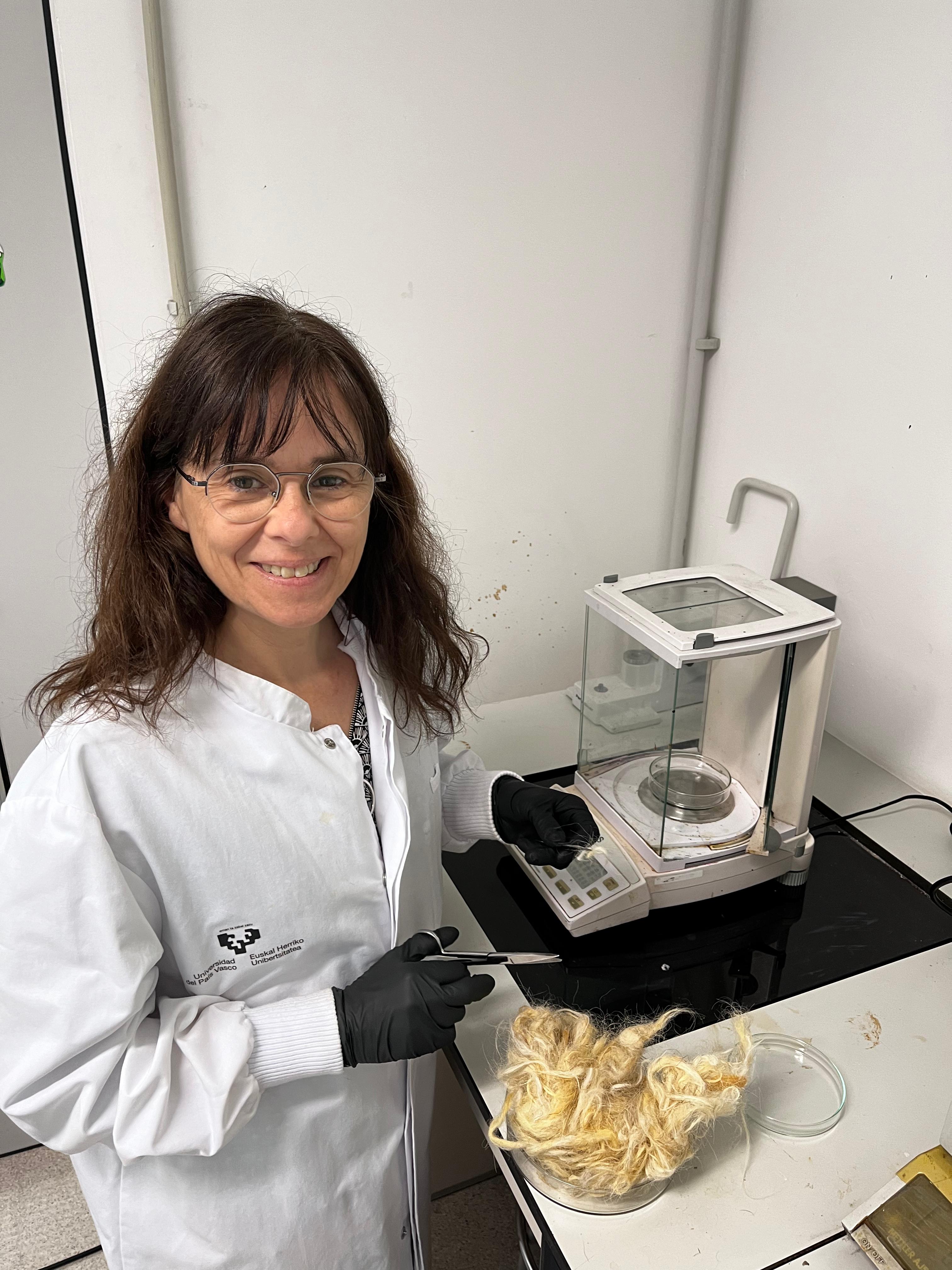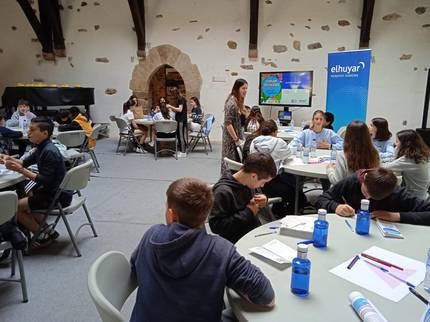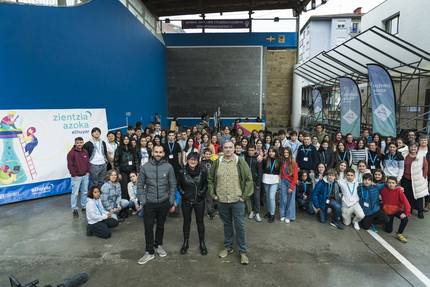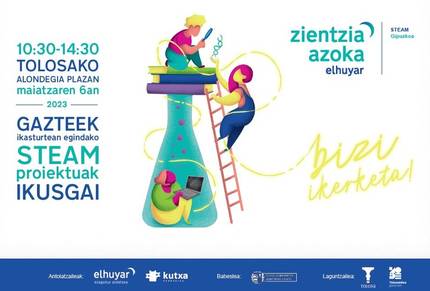“I would like to underline the desire and participation of girls in research into the use of wool in Beasain”
2024/05/08 STEAM-Hezkuntza (Elhuyar Zientzia)
The 3rd ESO students from the I.E.S. Txindoki de Beasain, together with the research group “Materials and Technologies” of the researcher at the School of Engineering of Gipuzkoa Cristina Peña Rodríguez, have analyzed the use of wool within the project “Mesa de Gluones para la inspiracion de los joven”. They have known the possibility of wool passing from by-product to raw material.
 None
None
Your research group is called “Materials and Technologies.” Who are you in the group?
Our research team is about 25 researchers. The group was created in 1988 by Professor Iñaki Mondragon. He currently runs Arantza Ezeiza and we have thirteen professors, professors from the Gipuzkoa School of Engineering, belonging to different departments, mostly chemical. On the other hand, there are also researchers who are doing postdoctoral studies, doctors and students who are doing a final degree and master's degree work.
What do you do?
Our goal is to develop materials with special properties and apply them in different areas.
When the group was formed, we worked mostly with synthetic polymers. Synthetic polymers or, as we say on the street, plastics. In 2000, when I started with the thesis, we started to study materials from renewable sources, from different trees or plants, natural oils, etc. In 2012, after the incorporation of Arantza Ezeiza as director of the group, we began to analyze the recycling processes. That is, new raw materials that would serve for recycling. In this sense, our research has mainly focused on wool. We've worked a lot with wool. Wool is a hair produced by sheep and is renewable.
What work have you done so far?
The project began with a reflection. Among the materials we observed that fibres from plants such as sisal, jute or hemp were used. Most of them are not plants in the Basque Country. Studying the material possibilities here, after many works, we come to wool with the Fraisoro School. We investigated the possibilities of using latxa sheep wool.
Wool, on the one hand, can be used as a fiber to produce composite materials, as a reinforcement. And on the other hand, it has an outer lanolin, that kind of oil that has hair, that also has our hair. Also keratin. These properties have been considered for study and application in different areas. Among them, construction.
In Basque Country we have many sheep. What about wool?
In general, latxa sheep wool is exposed. In the Autonomous Community of the Basque Country, for example, there are more than 300,000 sheep and, taking into account that between 2.5 and 3 kg of wool per sheep are produced each year between 750-900 t of wool.
Latxa sheep's wool is rough. When used in clothing, for example in household clothing, itching is very common. Due to this lack of comfort, and due to the production of other synthetic and cheaper materials, wool was discarded in our uses. Also for making mattresses or carpets.
Pastors say they bought wool years ago. Today, however, pastors have to pay to remove their wool. It is used as waste.
Currently, more and more efforts are being made to seek a use. I know that projects are underway. For example, at Baztan there is an ongoing programme to carry out this collection process between communities. In a company in Navarre, wool was used as insulation to control moisture, among other things. Ternua also uses latxa sheep wool in “ARTILESHELL” suits.
But in general, most wool is usually treated as waste.
In recent months, the young people of the IES Txindoki of Beasain have joined your research. What have you done?
That's it. We found it interesting to analyze along with them the interesting properties of the mixture of gypsum and wool.
In the first session, we went to his institute and we threw them the challenge. Specimens of different composition of wool and plaster were made to see the weights the specimens could withstand. Only plaster has been used in some specimens, while plaster has been mixed with wool in others.
Then, to see the resistance, they put a cube hanging from the specimens. Gradually they have been gaining weight until breaking the specimen. So you've seen what's the most powerful composition and, therefore, the best ownership. As an anecdote, I want to mention that because they couldn't break the test tube, they had to use creativity. The young men used their weight and, after several tests, the test tube came to bear the weight of two girls.
In the second session they have been present in our laboratories. They bring those specimens created at the institute to test them in laboratory machines. In addition, I think this visit could serve to remove the fear of college.
In the last session we will return to the institute to share with them reflections and draw conclusions.
Young people will be able to present the results of the research in Elhuyar Zientzia Azoka, Bilbao and Gipuzkoa. How important is this?
Whatever the object of study, these projects are very important to foster the spirit of research among young people. I think the trade shows are empowered. In other words, young people believe that research has been done by themselves. In addition, thanks to the presentation of the fairs, they bring the issue to the streets and communicate the problem to the citizens who come closer.
How do young people appear? What gives you?
I tell you, I'm a professor and a university researcher. That my passion is the development of materials and the more efficient use of raw materials.
It makes me a lot of illusion to work with young people, they convey their illusion and motivation. Although there is everything, there are always young people listening with their mouths open. For example, at the beginning of the challenge, we asked them, "Where do we get all the raw materials from?" We explain that the Earth is our only pantry, and from it we extract 100 gigas of tons a year. “How many years will Earth last?” They were shut up. Such statements arouse a passion for research. I would say that in university classrooms, in general, this curiosity and illusion is lost.
On the other hand, it is a good opportunity for us to take our research out of the lab. Otherwise, we have no relationship with young people and society in general. This project has given us motivation and strength. In this regard, I would like to thank the Elhuyar team and the Elhuyar technician Joseba Aldasoro Galan.
What is the role of teachers in this whole process?
In this case, Ainhoa Izagirre, a teacher, has been the guide for young people. He has been in contact with us, making gestures and transmitting to the youth the steps to follow. We have been with young people three times, but among these sessions young people have worked a lot. The key is to find the right people, and in this case we've invented it. It was a pleasure to work with Ainhoa Izagirre.
The pilot test of this study was carried out in Beasain. Looking ahead, do you find it interesting that HD centers know your research and participate in projects like this?
Sure enough. This year has been a pilot test and I would repeat it very well. This time, wool has been used with plaster, but we could work on other points of view in the project.
It's very interesting, on the one hand, because science works beyond the theoretical level. Addressing the current social challenges will require young people to develop other skills.
They also believe that science is necessary for sustainable development. We must take account of what surrounds us and how we can exploit it. In this respect, we have insisted on the idea of circular economy.
What would stand out from this lived experience?
I should like to underline the desire and participation of girls in research into the use of wool in Beasain. Most students have been female. There's only been one guy in the group. We didn't expect such a feminine group. So I want to remind you that science is a matter for girls.
This project, promoted by Elhuyar, is supported by the Department of Economic Promotion and Strategic Projects of the Provincial Council of Gipuzkoa.

Gai honi buruzko eduki gehiago
Elhuyarrek garatutako teknologia






